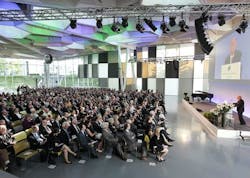Berthold Leibinger prizes awarded for applied laser technology, Future Prize goes to Gérard Mourou
(Image: Professor Berthold Leibinger, foundation founder and former managing partner of the TRUMPF Group, addressed 700 guests during the award ceremony)
The Berthold Leibinger Stiftung celebrated the 9th presentation of its laser prizes on September 9, 2016, before 700 guests. The jury awarded four innovation prizes and Professor Gérard Mourou received the Berthold Leibinger Zukunftspreis (Future Prize). The awards come with prize money: 30,000 euros for the Zukunftspreis and first prize, 20,000 euros for each of the two second prizes, and 30,000 euros for the third prize.
The event was opened by foundation founder and former managing partner of the TRUMPF Group, Professor Berthold Leibinger. “The Berthold Leibinger Innovationspreis is the most important work of this foundation, and so I am grateful to see that the awards ceremony is receiving so much attention from the general public.” The awards presentation began with film portraits of the prizewinners and their work. The prizewinners were chosen during a jury meeting last May.
Related:Short film portraits of the prizewinners and their work - very engaging and informative on a YouTube Channel
In addition, since 2006, the Berthold Leibinger Zukunftspreis has been honoring one scientist for outstanding contributions to applied laser technology. In 2016, this honor was awarded to French professor Gérard Mourou of the École Polytechnique. Due to his invention of chirped pulse amplification (CPA) at the University of Rochester, NY, in collaboration with his student Donna Strickland, Mourou is considered the “father” of electromagnetic fields of high and ultra-high intensity fields, as laudator Ursula Keller said while explaining the jury’s choice.
With CPA, Mourou pioneered the field of femtosecond ophthalmology with more than one million patients a year today, and revolutionized the field of high intensity lasers. Most recently, he initiated Europe’s Extreme Light Infrastructure ELI in the Czech Republic, Hungary and Romania.
Related:High-energy Lasers: Extreme light in zeptoseconds--recent feature by Gérard Mourou and colleagues
Related:National Energetics' 10 petawatt laser system for ELI passes major milestone
The first prize of the innovation award was presented to Swiss physicist Dr. Balthasar Fischer, who developed a membrane-free microphone at Vienna University of Technology that can hear through light. Marketed through Fischer’s company Xarion Laser Acoustics, the microphone is now finding applications in non-destructive metrology and the process control of machine tools. The microphone is also ideal for use as a sensor for optoacoustic imaging in biomedical engineering.
One of the second prizes was awarded to the founders of Crystalline Mirror Solutions, Dr. Garrett Cole from Santa Barbara, CA, and Dr. Markus Aspelmeyer, professor at the University of Vienna. They developed crystalline semiconductor coatings for high-performance cavity end mirrors, which for example can improve the precision of optical atomic clocks by orders of magnitude. Their mirrors have revolutionized the world of optical high precision measurement.
Another second prize was awarded to a total of twelve scientists from Saarbrücken and Dresden led by Professor Frank Mücklich and Professor Andrés-Fabián Lasagni. Mücklich’s working groups at Saarland University as well as the Steinbeis Forschungszentrum Material Engineering Center Saarland and Lasagni’s working groups at the Fraunhofer Institute for Materials and Beam Technology and at the Dresden University of Technology researched and developed the processes and laser systems to quickly and economically generate tiny micropatterns and nanopatterns using the effect of laser interference. Surfaces functionalized in this manner can reduce friction to a large extent or they can kill bacteria and thus reduce the transmission of germs. This technology will also be used to increase the reliability of electrical plug-in connections, such as in automobiles.
For the third prize, a total of 33 developers of the Laser Guide Star Alliance were the winners. Their high-power laser system is one of the key elements used in the construction of contemporary large telescopes on Earth. Based on earlier patented work and prototypes by ESO, the international industrial consortium of TOPTICA in Garching, Germany, and MPB Communications in Montreal, Canada, jointly developed a novel laser system. This technology offers advantages for the tracking of satellites and the detection of space debris as well as further applications. The respective groups were headed by Dr. Wilhelm Kaenders from TOPTICA, Dr. Wallace Clements from MPB and Dr. Domenico Bonaccini Calia from ESO.
Related:ESO's Very Large Telescope sees four times first (laser) light--July 2016 cover story written by the award winners for Laser Focus World
The next awards ceremony will take place in 2018. Applications for the innovation award may be submitted until December 31, 2017.
Source:Berthold Leibinger Stiftung
(Image below: Members of the team of developers from the Laser Guide Star Alliance, which won the Berthold Leibinger third place Innovation Prize.)
About the Author

Conard Holton
Conard Holton has 25 years of science and technology editing and writing experience. He was formerly a staff member and consultant for government agencies such as the New York State Energy Research and Development Authority and the International Atomic Energy Agency, and engineering companies such as Bechtel. He joined Laser Focus World in 1997 as senior editor, becoming editor in chief of WDM Solutions, which he founded in 1999. In 2003 he joined Vision Systems Design as editor in chief, while continuing as contributing editor at Laser Focus World. Conard became editor in chief of Laser Focus World in August 2011, a role in which he served through August 2018. He then served as Editor at Large for Laser Focus World and Co-Chair of the Lasers & Photonics Marketplace Seminar from August 2018 through January 2022. He received his B.A. from the University of Pennsylvania, with additional studies at the Colorado School of Mines and Medill School of Journalism at Northwestern University.
